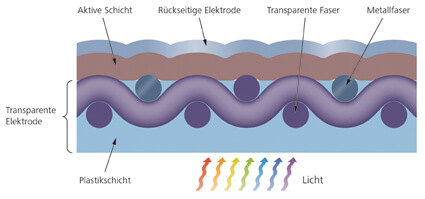Due to their high cost, transparent electrodes, of the type commonly used in touch screen phones, cannot be used in solar cells. Now there is a replacement

Conventional, rigid silicon-based solar cells on the market are not suitable for producing thin-film, designable solar cells, where transparent, flexible, electrically conductive electrodes capture the light and pass the current on. A polymer electrode provides the first evidence that a novel material could be suitable for indium tin oxide coatings.
The shortage of raw materials and the increasing use of rare materials make electronic components and their devices more and more expensive. Such rare metals, which are used, for example, to make transparent electrodes found in touch screens of mobile phones, liquid crystal displays, organic diodes and thin-layer solar cells. The material chosen for these cases is indium tin oxide (ITO) - a particularly transparent mixture of oxides. However, due to the high cost of this material it is not economical to use it for large-scale applications, such as solar cells.
Transparent oxides that do not contain indium do exist, but in light of their increasing consumption, they also become expensive and rare over time. In addition, the main disadvantages, such as their fragility, still exist. In light of this, a frantic search has been made for alternative coatings that are both transparent and electrically conductive, consisting of materials such as conductive polymers, carbon nanotubes or graphene. However, carbon-based electrodes usually exhibit high surface resistance, a characteristic that makes them poor electrical conductors. If a metallic skeleton is incorporated in the organic layer, the result is a reduction in resistance and an increase in mechanical stability. If a solar cell made of this material is bent, the electrode layers break and no longer conduct. In light of this, the great challenge is to prepare conductive materials that are flexible and durable at the same time, and whose industrial processes for their preparation will be economical.
One particularly promising option is the use of a flexible and transparent woven polymer developed by researchers from the Swiss Federal Laboratories for Materials Research and Testing (Empa) in collaboration with the commercial company Sefar AG. This company, which specializes in special fabrics, is able to produce the woven polymers in large quantities and economically. Metal wires woven into the polymeric material ensure that the material will conduct electricity. In the next step, the material is inserted into an inert plastic layer that does not cover the entire area of the wire, thus ensuring that the conductivity is maintained. The electrode obtained in this process is transparent, stable and flexible enough so that it can be folded. In the next step, the researchers covered this innovative material of theirs with a variety of coatings in order to prepare an innovative organic solar cell whose efficiency is similar to the efficiency of conventional cells based on indium tin oxide.
